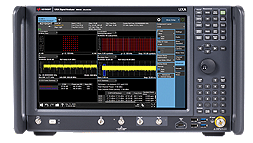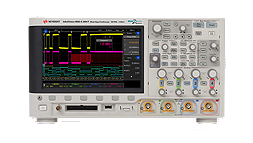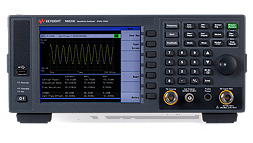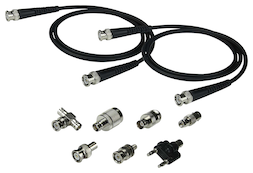Used Spectrum + Signal Analyzers
The Used Equipment web is currently available in English only and pricing is in USD for the United States.Prices for other countries will vary.
Spectrum analyzers measure a signal’s spectral power density in order to both analyze known signals and identify unknown interference. This makes them indispensable when evaluating a signal’s frequency-domain characteristics not easily observed in time-domain waveforms. More advanced signal analyzers even unite measurements from both domain types in one instrument.
Spectrum + Signal Analyzers Quick-Facts
What is a signal analyzer?
A signal analyzer is a device used to test and measure electronic signals. Types of signals can vary, including voltage, current, and radiofrequency. Signal analyzers vary in their capabilities and features, depending on the application. There are many types of signal analyzers, but the most common type is an oscilloscope. Other types include spectrum analyzers, network analyzers, and signal generators.
An oscilloscope is a device used when designing electronic systems that allows a signal to be viewed as a waveform. A spectrum analyzer measures the amplitude and frequency of signals over a specific period of time. A network analyzer analyzes circuits without having access to their design details; this can be helpful when there is a delay between creating a circuit and testing it. A signal generator generates signals which are then used by other devices.
There are many uses for a signal analyzer, depending on the type of device and features available. Some standard capabilities include:
Generating and analyzing signals
Magnifying and analyzing large signals
Displaying waveforms of varying types
Displaying the full frequency range of a signal, including visual representations of different frequencies and noise levels

Vector Signal Analyzer vs Spectrum Analyzer – What's the difference?
A signal analyzer analyzes signals that have already been generated, whereas a spectrum analyzer is used to discover frequencies or actually generate frequencies itself.
A spectrum analyzer performs real-time spectrum analysis and measures instantaneous power or peak power, voltage, or current, depending on the type of signal being analyzed. It is also often used to monitor electromagnetic interference in circuits and devices.
On the other hand, a signal analyzer can only measure signals that are already present; it cannot be used to discover or analyze frequencies. Its purpose is to help the user identify electronic circuit problems and understand how the circuit is performing.
Signal Analyzer vs Oscilloscope – What's the difference?
The main difference between a signal analyzer and an oscilloscope is that a signal analyzer analyzes the voltage of a signal over a specific period of time. In contrast, an oscilloscope extracts the timing information of a signal.
An oscilloscope is a type of signal analyzer used to measure voltage signals over time. It has various features, including analog and digital functions, advanced triggering capabilities, and connectivity options. It is used to analyze signals from many different sources, such as time-domain signals, frequencies from radiofrequencies, or extremely low-frequency sources.
A signal analyzer is used to analyze signals that have already been generated. A signal analyzer is often used to monitor electromagnetic interference in circuits and devices, whereas an oscilloscope can only measure signals that are already present.


Figure. 2 Oscilloscope vs. Signal Analyzer
Read our oscilloscope basics guide to learn more about oscilloscopes and their uses. To see our full range of new and used oscilloscopes, visit our product listing page.
Signal Analyzer vs. Vector Network Analyzer – What's the difference?
A network analyzer is used to test the performance of wired or wireless networks by examining both transmitted and received signals. Unlike a signal analyzer, it performs advanced analysis of both transmitted and received signals. It is different from a signal analyzer because it performs a live, real-time, analysis of signals on the device under test. In contrast, a signal analyzer only analyzes data after the signal has been created.
A network analyzer can also perform analysis and detect problems that prevent a signal from reaching its destination. For example, it can detect issues with cabling, connectors, or faulty equipment. It can also help resolve RF spectrum and Wi-Fi issues, such as interference and signal loss.
A signal analyzer is used by engineers to identify problems in electronic circuits and to understand how a circuit is behaving; for example, monitoring electromagnetic interference between multiple signals or devices. This makes it useful for testing and debugging circuits that use radio signals or other powerful sources of potential interference.
How to measure antenna impedance with a signal analyzer?
An antenna's impedance refers to the way it responds to signals from specific frequencies. If you want to know what sort of wireless signal a device is sending, you should evaluate the antenna's impedance with a spectrum analyzer. The device would help you determine whether or not your antenna is being affected by noise, which can negatively impact performance.
To measure your antenna's impedance, you can attach a spectrum analyzer to the end of the coaxial cable connected to the back of your antenna. The device will then calculate the impedance being transmitted once it goes through your coaxial cable.

How to measure phase noise with a signal analyzer?
Phase noise is a type of signal that often disrupts or interferes with wireless communication. It is a problem for devices that operate in the wireless frequency spectrum. If phase noise is common across specific frequencies, it can drown out other signals.
There are many different types of phase noise, and each one can affect your wireless technology differently. A signal analyzer measures the phase noise across different frequencies. The device will help you to determine whether your intended wireless communication needs some sort of interference protection.
To measure your device's phase noise with a signal analyzer, you can attach the device to the input of your receiver. This will allow the signal analyzer to calculate how much phase noise is being sent through your wireless communication devices.
How to measure return loss with a signal analyzer?
The return loss is the measurement of how much signal is reflected or wasted at a particular point. It is a measurement of how much energy is being lost in transmission. You can measure return loss with a spectrum analyzer which may enable you to improve the power and efficiency of your wireless connection.
If the return loss is too high, it could indicate power-management issues within your system. A signal analyzer can help you determine whether the return loss is too high, and help you find any hardware issues needing to be resolved. The device can notify you when your power-management settings fall below requirements for successful wireless communication.
To test a device’s return loss with a signal analyzer, plug the spectrum analyzer into the end of a coaxial cable connected to your intended transmitter. The device will determine how much signal is lost after it goes through the cable and exits to reach its intended recipient.
For additional information about how to use your spectrum analyzer to measure return loss, view “Features Resources” for a technical overview of a basic spectrum analyzer as well as an example of how to measure the return loss of an antenna.











































